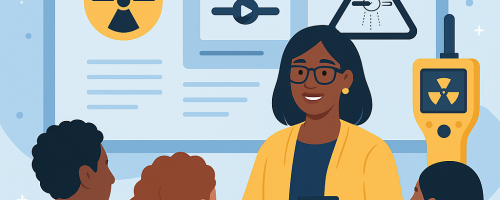Today we are remembering all those who lost their lives working to make our lives better.
By Steve Horvath, President and CEO of the Radiation Safety Institute
Every year more than 900 people die in workplace accidents. This is more than a just a number. Every fatality carries with it a story of pain and loss that will forever stay with those left behind – families, friends and colleagues.
The staggering number of tragic incidents across the country is distressing; 900 is a sobering number. We all deserve a safe workplace and our families deserve the comfort that we will be back home safe and healthy at the end of the day. But as unacceptable as this fatality statistic is, we cannot lose sight of other risks and hazards in the workplace, particularly occupational disease — which can also be deadly, and that is equally unacceptable.
On the National Day of Mourning, the team of the Radiation Safety Institute of Canada would like to remind all workers and employers of the potential hazards that radiation sources have on employee health if not handled properly. It is a common misconception that radiation-emitting devices and radioactive materials are mostly used in the nuclear power industry. The reality of a modern Ontario workplace is that the application of radiation is found in almost every industry: health care, construction, manufacturing, power generation, pharmaceutical, security, veterinary practice, education, transportation, utilities, etc. Nuclear gauges, X-ray machines, lasers, CT-scanners and different radioisotopes are just a few examples of commonplace radiation devices and sources used by Canadians on a daily basis.
 Furthermore, not all radiation is man-made. Naturally occurring radioactive materials (NORM) also pose a potential risk and can create a workplace hazard, the most common example being radioactive radon gas. The Canadian labour force accounts for approximately 19 million individuals. Hundreds of thousands of Canadian workers come in contact with radiation daily. If we include naturally occurring radioactive material, we are looking at a potential exposure of millions of people. When not handled properly, radiation hazards present a significant health and safety risk. The main risk associated with a radiation hazard is excessive exposure that, in turn, may lead to acute injuries (e.g., radiation burns) or long-term disease, like cancer.
Furthermore, not all radiation is man-made. Naturally occurring radioactive materials (NORM) also pose a potential risk and can create a workplace hazard, the most common example being radioactive radon gas. The Canadian labour force accounts for approximately 19 million individuals. Hundreds of thousands of Canadian workers come in contact with radiation daily. If we include naturally occurring radioactive material, we are looking at a potential exposure of millions of people. When not handled properly, radiation hazards present a significant health and safety risk. The main risk associated with a radiation hazard is excessive exposure that, in turn, may lead to acute injuries (e.g., radiation burns) or long-term disease, like cancer.
According to Statistics Canada, cancer is the leading cause of death in Canada, surpassing heart disease mortality rates by 10% as of 2011. The Canadian Cancer Society estimates that two out of five Canadians are expected to develop cancer during their lifetimes and a quarter of Canadians are expected to die from cancer.
Because cancer latency periods can span 20 to 30 years, it is not always easy to pinpoint the exact time and place, or even the period of time, when the cancer-causing exposure may have happened. But we do know that when such outcomes occur, it has the potential to translate into an immense stress for workers and their families, as well as millions of dollars in medical care costs, insurance claims to the WSIB, and costs associated with disruption of operations for the employers.
What we can do today is take a proactive approach to radiation safety in the workplace and remember that a proper radiation protection program and its implementation, along with timely testing for such hazards as radon gas, can prevent cancer in the future.
The Radiation Safety Institute of Canada believes that education and awareness are key to staying safe. We know there are many work priorities with which we all struggle and that many hazards, such as radiation, are undetectable by human senses and may fall to the back burner. We encourage you to consider making an investment in your future health today: simply take a moment to think whether or not you have all the knowledge and controls in place to be safe around radiation.
Let’s get educated, stay informed, take radiation protection seriously and make the right decisions about radiation safety in the workplace today. And remember, we are always here to help answer questions and provide guidance with “Good Science in Plain Language.”
Steve Horvath is President and CEO of the Radiation Safety Institute of Canada. He is formerly the President and CEO of the Canadian Centre for Occupational Health and Safety, a national organization dedicated to promoting the total health and well being of working Canadians. In addition to his leadership at the CCOHS, he has held senior executive positions with companies in the technology, manufacturing and service sectors including responsibilities as President and CEO of multi-national companies.







